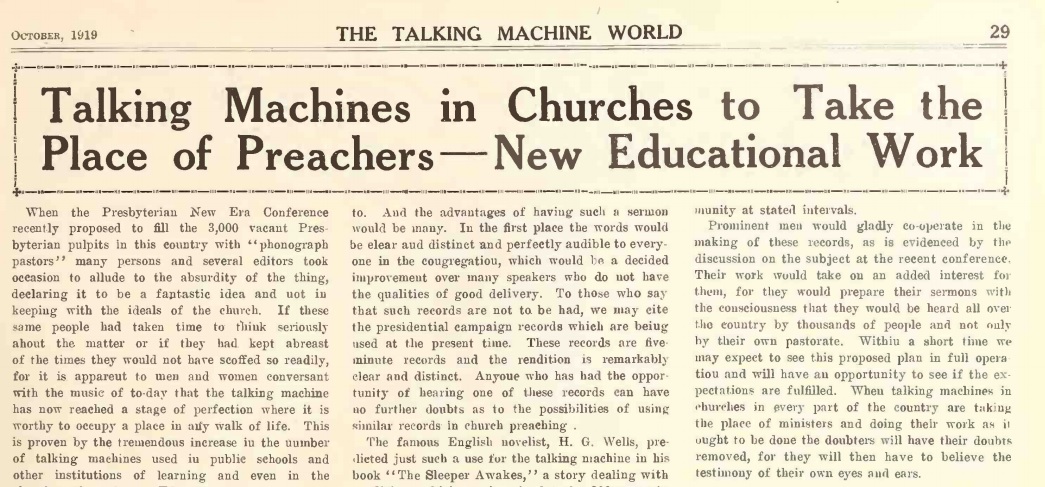 At its 1918 General Assembly, the Presbyterian Church USA created the New Era Expansion program, an attempt to hammer out a five year plan to foster cooperation and unity among Presbyterian bodies.
At its 1918 General Assembly, the Presbyterian Church USA created the New Era Expansion program, an attempt to hammer out a five year plan to foster cooperation and unity among Presbyterian bodies.
A New Era conference was held at Lake Geneva Wisconsin on September 9, 1919, and one of the actions taken is detailed in this article, from Music Trades magazine, September 13, 1919:
PHONOGRAPHIC SERMONS FOR PASTORLESS CHURCHES
Presbyterian Conference Recommends Use of Phonograph Records of Approved Sermons in Vacant Pulpits
LAKE GENEVA, WIS., Sept. 9.—”Phonographic sermons” are a possibility in pastorless Presbyterian churches as a result of action taken to-day at the Presbyterian New Era conference, after it was disclosed that 3,000 of the 10,000 Presbyterian pulpits are vacant.
The delegates outlined plans for filling those pulpits temporarily until ordained ministers could be obtained. Dr. W. S. Marquis of Chicago, associate secretary, urged each presbytery to develop immediately strong laymen as leaders and indorsed the recommendations that phonograph records of approved sermons by ordained ministers be provided for use in vacant pulpits.
According to the October 1919 issue of Talking Machine World, the proposal had some doubters. But not surprisingly, the magazine eagerly supported the proposal. It noted that of the 10,000 Presbyterian pulpits in the country, a full 3000 were vacant. While those congregations took steps to fill the gaps, “there is nothing so monotonous and lacking in appeal as a poor preacher. On the other hand, congregations could acquire records of sermons by great preachers, and “half a dozen five-minute records would make a sermon that would be worth listening to.”
In particular, “the best sermons of a $20,000 preacher could be had in any church for the cost of a machine and a few records. Can anyone imagine that a congregation would not prefer to listen to the voice of a great minister, representing the highest intellect and the finest expression of religious thought to be found in the church, rather than the hackneyed phrases of a man who struggles along in martyrdom trying to eke out his $70 salary with preaching ability of the same worth.”
Particularly in rural areas served by circuit-riding preachers, the phonographic preacher would be a Godsend. Some churches saw a real preacher only once every two or three weeks. But with a library of records and method to distribute them, new sermons could be supplied each week, and even during the week.
